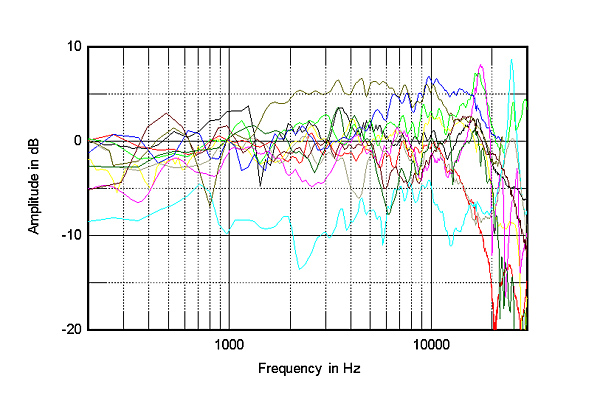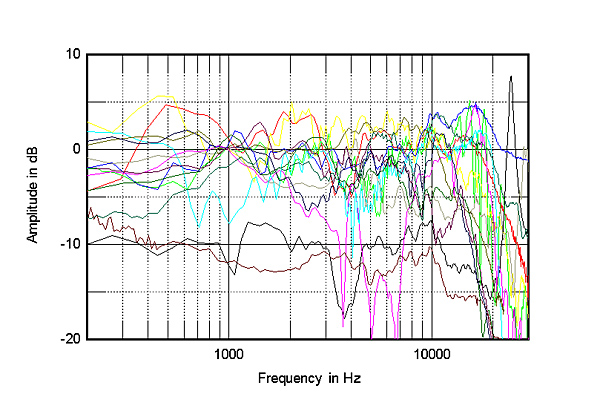| Columns Retired Columns & Blogs |
Interesting ...... Only 3 loudspeakers in that list made it to Class-A rating :-) .......

Fig.6: This is a mixed bunch, with some models highly recommended—the Wilson WATT 3, Rogers LS3/5a, Thiel CS5—and others that appear comparably flat either recommended only as budget models or not at all. This reinforces what I said earlier: Flatness of frequency response is not the only relevant parameter when it comes to judging speaker quality, and you must read the original reviews to see how shortfalls in any one area can be balanced by strengths elsewhere. There is one measurement anomaly in this group, the Thiel CS5. This has been downgraded by my flatness criterion because of its energy mismatch below and above 2kHz. I'm reasonably sure that this is an artifact of my measurement technique, it being impossible to position the measuring microphone far enough from the speaker to capture a true picture of its midrange balance. This is due both to the speaker's multiplicity of drive-units, each covering just a small nominal passband, and to the fact that the crossover uses first-order, 6dB/octave slopes, meaning that the overlap between the drivers is maximal.
Note that the Snell K/II's response was taken with the tweeter-level control set to give the flattest response on the tweeter axis; the curve published in the magazine had the HF control at its maximum setting. Note also that the Acoustat Spectra 1100 curve is the response midway up the electrostatic panel rather than that averaged across a 30° window, due to the speaker's very limited dispersion in the top two octaves.

Fig.7: This final group is to a large extent the rogues' gallery when it come to frequency response. It is a rare speaker as unflat as the majority of these that gains anything but a very qualified recommendation from Stereophile's reviewers unless it is extremely inexpensive. The major exception is the Apogee Stage, which ends up here due to its sloping response across the band resulting in a high standard deviation. As DO's review pointed out, however, the smoothness of its response trend leads to a very natural, seamless midrange quality which can easily become addictive. Note also the Celestion 3000, which has a seamlessly flat midband typical of speakers in the higher groups. It ends up in this group, however, because of its early HF rolloff, which is accentuated by a peaky mid-treble. But in general, if you design a loudspeaker with these kinds of frequency-response aberrations, the worst thing you can do is submit it to Stereophile for review. (To be fair to Polk and Cambridge SoundWorks, we went out and bought our review samples.)
Overall Conclusions I think it's apparent from the data that while flatness of midrange and treble response is a good thing to have in a loudspeaker, it doesn't in itself mean that the speaker will sound good, or lead to an automatic recommendation by Stereophile. There also appears to be no correspondence between flatness of on-axis response and price. On the other hand, once the response flatness deviates above a certain level—a frequency-weighted standard deviation of approximately 3.5dB, for example—it's unlikely that the speaker will either sound good or be recommended. Exceptions are: a) if the speaker is very cheap or its errors are in a relatively innocuous part of the frequency spectrum (Monitor Audio 7, Cambridge SoundWorks Ambiance, Dana Model 1, for example); or b) if the standard deviation is high because of an overall smoothly tilted response (Apogee Stage and Meridian D600, where the tilt is downward; Rogers LS3/5a and Wilson WATT 3, where the response tilts upward); or c) if the speaker is otherwise superb in almost every respect. (There's also the Thiel CS5, whose poor showing is due more to its first-order crossover and multi-unit design mandating measurement conditions that I was unable to achieve.)
It's also apparent that a speaker with a basically smooth, flat response but a single area of unevenness—due perhaps to a strong woofer-cone breakup mode or a cabinet resonance—will be downgraded accordingly (Wharfedale Diamond IV, Dick Olsher Black Dahlia, TARA Labs Timekeeper, which all sound nasal as a result).
The same holds true for crossover or drive-unit integration problems (Triad System Seven, Waveform, the original Dahlquist DQ12, the original Focal Aria Mk.I JM Lab Micron, Acoustic Energy AE2, Amrita AMRIT-Minimonitor). Similarly, if a speaker has a flat response but limited high-frequency dispersion, its appeal will be limited due to the room reverberant field tending to sound too lifeless (JBL XPL-90 and '160, Acoustat Spectra 1100 and Spectra 11, Celestion 3000, Polk RTA 11t).
And no matter how flat the midband, a somewhat loose, underdamped low-frequency region (JBL XPL-90, Phase Tech PC-80) is an almost unforgivable fault for many listeners, except when balanced by a degree of HF emphasis or a tilted-up treble (Rogers LS3/5a and LS7t, JM Lab Micron 2, PSB 40 Mk.II and Stratus Gold, Nestorovic 5AS, Celestion SL700, Monitor Audio Studio 10, Snell K/II and E/III, Ensemble PA1 and Reference, sample 2 of the Dahlquist DQ12).
Conversely, the worst thing a speaker designer can do with a speaker that has an overdamped, lightweight bass alignment is to give his brainchild a tilted-up treble balance (AR Spirit 152, Vieta Pro-5, SOTA Panorama, MB Quart 490, WATT 3 without the Puppy). The lack of across-the-band balance is musically disturbing, and the emphasized treble exaggerates problems elsewhere in the system.
Interestingly, if a speaker is rolled-off at both extremes, it seems to sound more acceptable than might be expected from its flatness quotient as calculated here. The Spica TC-50 and Cambridge SoundWorks Ambiance both benefit from this fact, the former actually getting a recommendation totally out of proportion to its price. Although not measured during this time period, the Celestion SL600Si which I reviewed in May 1989 also falls into this category. If this somewhat midrange-forward balance is not smooth, however, the ear seems to detect the unevenness as a cupped-hands coloration—again, the Acoustic Energy AE2 and Amrita AMRIT-Minimonitor both suffered in this respect. And the opposite response trend, a lack of energy in the upper midrange (Infinity Modulus to a small degree, Polk RTA 11t to a gross degree), can lead to a musically uninvolving presentation.
The best loudspeakers, in my opinion, combine a flat on-axis midrange and treble with an absence of resonant colorations, a well-controlled high-frequency dispersion, excellent imaging precision, an optimally tuned bass, and also play loud and clean without obtrusive compression. But you'll have to read the reviews to find out which they are. (And now that I've laid out for all you designers out there exactly how a speaker should be designed to get a good review in Stereophile, I expect the entire 1992 crop to conform to this specification!)—John Atkinson

Interesting ...... Only 3 loudspeakers in that list made it to Class-A rating :-) .......

A few thoughts along what you've already written:
• The two biggest areas where subjectivist reviewers and their advocates go wrong is in making the proclamation that measurements give no information on how the product sounds. I think you have shown that to be wrong over the years.
• While everything you can measure can be heard (given the criterion and the method used), everything you can hear still can't be measured. That being said, the measurements and the systems used to make them offer a lot of insight into the item being put under scrutiny.
• The human senses are not perfect and neither are our memories of our sensorial experiences. While the test equipment John uses is not perfect, as long as it operates correctly it has no problem with flared up sinuses, migraines, tinnitus or any other factor that can effect human hearing on a daily basis.
• The sound of your room is just as important as the sound from your speakers. It's also easier & cheaper to improve your room sound and it can be done in stages to great effect rather than wholesale.
• Test equipment is a lot like a car: the most important part is the nut behind the wheel
Keep up the good work, you crazy guy!

Careful design is the most important aspect of product.
The "nut behind the wheel" might be a worst case scenario.
Every product is carefully scrutinized & measured, built with tolerances +/-, evaluated in laboratory settings, durability tested, production qualified, priced, packaged, weighed and compared with all known competitors.
Some folks might be "nuts behind the keyboard" but our JA isn't one of them.
Tony in Nevada

... listening to and, more importantly, enjoying music - rather than focusing on equipment - one could have done so much worse than to have chosen the Spendor S100.

There is a current version of Spendor Classic 100 :-) ..........

[[Redacted.]] :-)

John,
I don't know what your motivations were in posting this here, but it doesn't matter: I'm not going to allow Aczel's libels to be reposted on Stereophile's own website.
If anyone doubts JA's seriousness or significance to audio, I'll refer them to the Audio Engineering Society, which honored him with their Heyser award, which is a big deal.
Jim Austin, Editor
Stereophile